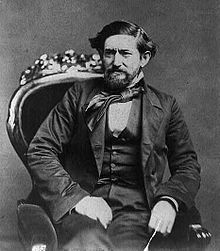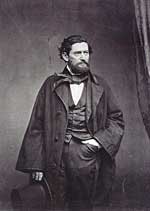John Coffee Hays
This article includes a list of general references, but it lacks sufficient corresponding inline citations. (December 2011) |
John Coffee Hays | |
|---|---|
 John Coffee Hays | |
| Nickname(s) |
|
| Born | January 27, 1817 Wilson County, Tennessee |
| Died | April 21, 1883 (aged 66) Piedmont, California |
| Place of burial | |
| Allegiance | |
| Service | Texas Ranger Division |
| Years of service | joined Rangers in 1836 |
| Rank | |
| Commands | 1st Mounted Texas Rifles Washoe Regiment |
| Battles / wars | |
| Other work | Sheriff, politician |
| History of Texas | ||||||||||||||||||
|---|---|---|---|---|---|---|---|---|---|---|---|---|---|---|---|---|---|---|
 | ||||||||||||||||||
| Timeline | ||||||||||||||||||
|
||||||||||||||||||
|
| ||||||||||||||||||
John Coffee "Jack" Hays (January 28, 1817 – April 21, 1883) was a captain in the Texas Rangers and a military officer of the Republic of Texas. Hays served in several armed conflicts from 1836–1848, including against the Comanche people in Texas and during the Mexican-American War.
Biography
Jack Hays was born at Little Cedar Lick, Wilson County, Tennessee. His father Harmon A. Hays fought in the War of 1812, naming his son for a relative by marriage, Colonel John Coffee.[1]
In 1836, at the age of 19, Jack Hays migrated to the Republic of Texas. Sam Houston appointed him as a member of a company of Texas Rangers because he knew the Hays family from his Tennessee years. Jack met with Houston and delivered a letter of recommendation from then-President Andrew Jackson his great uncle. Rachel Jackson was Jack's great aunt of the Donelson family a relative of his mother.
In the following years, Hays led the Rangers on a campaign against the Comanche in Texas, and succeeded in weakening their power. Jack rode with an Apache Chief named Flacco who led the charge into every battle with him. The duo led and inspired the Rangers. In 1840 Tonkawa Chief Placido and 13 scouts joined with the Rangers to track down a large Comanche war party,[2] culminating at the Battle of Plum Creek.[3]
Later, Hays commanded the force against the invasion from Mexico of 1842. During the Mexican–American War (1846–1848), Hays commanded the First Regiment of Texas Rangers at the Battle of Monterrey, established six companies along the northern and western frontier of Texas, and commanded the Second Regiment of Texas Rangers in Winfield Scott's Mexico City campaign.[4] The Rangers excelled during this conflict, gaining nationwide fame. Jack was the first to use the Navy Colt Patterson five shot revolver. He expedited Samuel Walker to meet with Samuel Colt which led to the design of the legendary Colt Walker six shot revolver used in the old west.
Marriage and family
On April 29, 1847, in the Magnolia Hotel, Hays married Susan Calvert, a descendant of George Calvert, First Baron Baltimore, in Seguin, Texas, where he had his home.[5][6]
The Comanche had great admiration for Hays. Upon the birth of Hays' first son in California, Chief Buffalo Hump sent the Hays family a gift, a golden spoon engraved "Buffalo Hump Jr."
When son John Caperton Hays married Anna McMullin in San Francisco, two Texas Ranger legacies were combined. Her father, Captain John McMullin, was one of Jack Hays' closest friends; he had followed him to California.
Jack Hays' brother was Confederate Brigadier General Harry T. Hays of New Orleans. Their sister Sarah "Sallie" Hays Hammond was the mother of John Hays Hammond.[7] John Hays Hammond, Jr., was an apprentice to Thomas Edison and worked with Nikola Tesla; he was on the board of directors for RCA.
Post-Mexican-war years

In 1849 Hays was appointed by the United States government as the US Indian agent for the Gila River country in New Mexico and Arizona.
The same year the Hays joined the migration to California, leading a party of Forty Niners from New York that traveled in wagons to California from Texas. This party pioneered a shortcut on Cooke's Wagon Road that saved a long journey to the south. That improved route became known as the Tucson Cutoff. Hays was elected sheriff of San Francisco County in 1850, and later became active in politics. In 1853, he was appointed US surveyor-general for California.[8][9]
Hays was one of the earliest residents of the city of Oakland. In the following years, he amassed a considerable fortune through real estate and ranching enterprises. In 1860, while in Virginia City, Nevada, on business, he heard the news of the First Battle of Pyramid Lake. He commanded a force of volunteer soldiers at the Second Battle of Pyramid Lake.
During the Civil War, Hays retired from military involvement.
In 1876, Hays was elected as a delegate to the Democratic Party national convention, which nominated Samuel J. Tilden for the presidency of the United States.
Jack Hays died in California on April 21, 1883, and his remains were interred at Mountain View Cemetery in Oakland.[10]
Legacy and honors
John C. Hays is the namesake of Hays County, Texas.[11] Hays is etched in his honor, on the side of the Hall of State, Dallas, Texas.
References
- ^ "A Great Captain and a New Weapon" by Charles M. Robinson III.
- ^ "Chief Placido", San Marcos Record, November 2007
- ^ "John Hays, Texas Ranger Hall of Fame, Texas Rangers Website
- ^ Ford, J.S., 1963, Rip Ford's Texas, Austin: University of Texas Press, ISBN 0292770340, p. 60
- ^ Weiss, Harold J., Jr. "Hays, John Coffee (1817–1883)". Handbook of Texas Online. Texas State Historical Association. Retrieved June 2, 2010.
{{cite web}}: CS1 maint: multiple names: authors list (link) - ^ Weinert, Willie Mae (1976). An Authentic History of Guadalupe County. Seguin Conservation Society.
- ^ "Unique". Time. May 10, 1926. ISSN 0040-781X.
- ^ Jack Hays
- ^ Texas Ranger Hays
- ^ John Coffee "Jack" Hays at Find a Grave
- ^ Gannett, Henry (1905). The Origin of Certain Place Names in the United States. Govt. Print. Off. p. 153.
- Gwynne, S. C. Empire of the Summer Moon: Quanah Parker and the Rise and Fall of the Comanches, the Most Powerful Indian Tribe in American History, New York: Scribner, 2010;
- Robinson, Charles, The Men Who Wear the Star: The Story of the Texas Rangers, Modern Library, (2001). ISBN 0-375-75748-1.
- Swift, Roy, Three Roads to Chihuahua: The Great Wagon Roads that Opened the Southwest, Eakin Press (1988). ISBN 0-89015-640-9.
- Webb, Walter Prescott, The Texas Rangers: A Century of Frontier Justice, University of Texas Press, (1965, second ed.).
- Wilkins, Frederick, The Legend Begins: The Texas Rangers, 1823–1845, State House Press, (1996). ISBN 1-880510-41-3.
- Wilkins, Frederick, Defending the Borders: The Texas Rangers, 1848–1861, State House Press, (2001). ISBN 1-880510-41-3.
- Wilkins, Frederick, The Law Comes to Texas: The Texas Rangers 1870–1901, State House Press, (1999). ISBN 1-880510-61-8.
External links
- John Coffee Hays from the Handbook of Texas Online
- John Coffee Hays at Find a Grave
